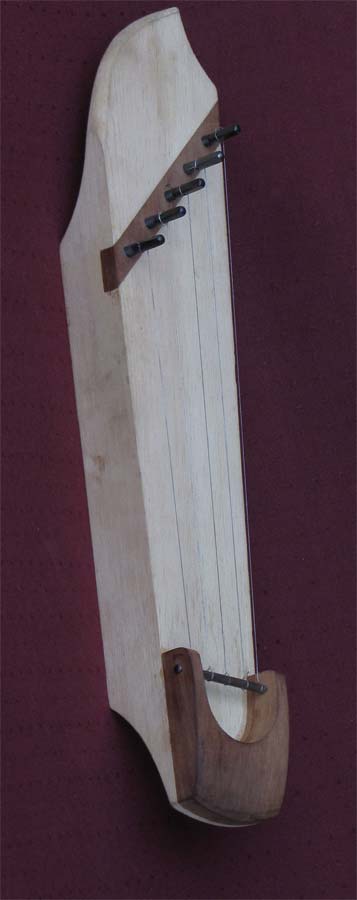I will in this case take a wide step from dry times and dates, and explain this instrument with a legend. An ancient god of the Finnish people - Väinämőinen - kept order in the chaos of the world of man, using wisdom and lore and music and, when needed, might. He played an instrument of his own invention, made from the jawbone of a giant fish and the hair of the devil's horse's tail. With this simple five string instrument he could influence the minds of men, bringing peace and joy. It was epic. As he was leaving this world, displaced by lack of faith and a belief in a new system, he created a magical wooden kantele, strung with the hair of a willing maiden, and left it with his people as a token of his love and affection until he returned to take it up and lead them again. Again, epic.
I will mention that the first time the story of this god was written as national epic saga was in 1835, but the first mention of him goes well back to the 900s. But that matters little, as for most of their existence the Finnish people have not had a written language of their own, and in contrast with the exceptional achievements in literacy of today, most before a hundred years ago were not literate. So there is little surprise that evidence of instruments cannot be found - that evidence simply wasn't written. Which leaves us a big blank slate, some of which we can fill from neighboring peoples, but there are still lots of empty spaces waiting for legend and imagination to fill. And after all isn't that half the fun of delving back into the mysterious past of these epic instruments of legen - wait for it - dary stature?
But we can do a bit better in the facts, even though the story is more fun. The instrument is integrally tied to rune-singing, a practice that developed between two-thousand and one-thousand years ago. These instruments belong to a family of psalteries known as Baltic Psalteries. They include the Russian Gusli, the Kankles of Lithuania and the Latvian Kokle among others. The simple five string version has been known as long as the instrument has been known, and today is as ubiquitous in Finland as the plastic recorder is in the U.S., used in much the same way as an introduction to music in schools for elementary students and played as a folk instrument at gatherings and festivals and around campfires. It is inextricably tied to the Finnish culture. The traditional kantele was built with up to fifteen strings, but the five and nine strings are by far the most common.
Another class of kantele, the concert kantele, with up to forty (and recently even more) strings, is an evolution of this instrument, but a modern one, and different in a lot of ways. And it can't be built from the jawbone of a large pike, and the devil's gelding gets hacked off if you try to take more than just a few of his hairs, so why should it concern us?

Standard Traditional Five String
Mechanically and
technically, this is the most common kantele.
Carved from one piece of wood, the sound chamber is open
on the bottom. The ponsi (string bar holder
assembly) is attached at the tail of the instrument, and
tuning pins are fitted to the head. Since this is
not a stopped string instrument, the notes are
determined not by thickness of the strings, but by
length, each being different from it's neighbor.
There are many ways of ornamenting this instrument,
carving on the body and head, cutting shapes and motifs
into the upper point, designing ornamental ponsi,
inlays, gilding and many other options. Aside from
being a solo instrument, two of these would make up a
traditional set, along with one piccolo instrument tuned
an octave higher. With this combination, rhythm,
melody and accent can be produced with instruments whose
sounds are perfectly harmonious. This example has
a pine body with a horsehead hook ornament gradient
stained in purple, a purpleheart and brass ponsi and is
strung in steel wire.

This
is the smaller brother of the traditional sized
instrument. Half the size, one octave higher in
pitch, with the same amazing tone and ease of
playing. Most of this sized instrument I have
built are part of a three piece performance set, but
several have been requested for coffee table or office
desk instruments, easy to keep, maintain, and play and
convenient for those times when anything else is too
cumbersome. This example is light cedar with
walnut inlay and ponsi.